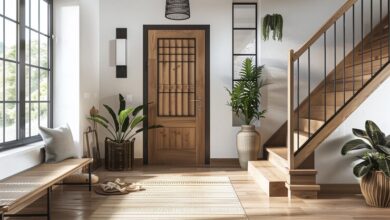The ultimate guide to composite and uPVC doors

The ultimate guide to composite and uPVC doors, The evolution of entrance doors over the past has led to the contemporary Upvc and composite door styles that we see today. In the interests of energy efficiency, security, and beauty, several materials have been employed throughout history—some more successfully than others.
From the robust and long-lasting olive wood used in Egyptian King Solomon’s temple doors to the stone-built doors of ancient India, which are thought to be more resilient and better at keeping heat. The Romans and Greeks experimented with single-block, double-sliding, and folding doors using materials like brass, stone, and wood.
Needless to say, door designs have come a long way since the olive wood doors of Egypt, and these days we have many options for materials and techniques we use to create the perfect entrance door. But, with the high standards of security and energy efficiency required for our modern-day lifestyles, how do you know which door design is best for you?
What are composite and uPVC doors and how are they different?
Composite doors and uPVC doors are both popular choices for modern homes due to their durability and aesthetic appeal.
Composite doors are made from a combination of materials such as wood, glass-reinforced plastic, and insulating foam.
Due to their construction, they are exceptionally durable and weather-resistant, making them suitable for extreme weather conditions and offering superior safety.
In contrast, since uPVC doors are made entirely of unplasticized polyvinyl chloride, they require less maintenance and are lighter in weight. Their superior insulating properties help retain heat and use less energy.
Although there are many different designs available for both composite and uPVC doors, composite doors have a more classic look, with detailed details and wood grain effects.
Additionally, composite doors are generally more expensive than uPVC doors due to their labor-intensive production process and use of higher-quality materials.
Ultimately, the choice between the two types of doors comes down to personal preference, budget, and desired aesthetic.
Are composite doors more energy efficient than uPVC?
Composite doors are indeed more energy efficient than uPVC doors. This is primarily due to the superior insulation properties of composite materials.
Unlike uPVC, composite doors are made from a combination of materials, typically a solid timber core encased in a durable insulating foam and reinforced with layers of glass fiber.
This construction ensures excellent thermal efficiency, minimizing heat transfer and preventing drafts.
Because of the insulating foam core, which acts as a barrier against extreme outdoor temperatures, the interior climate can be kept stable and comfortable all year long.
uPVC doors, on the other hand, are made of a single material, unplasticized polyvinyl chloride, which has lower insulation properties by nature.
Moreover, weather seals and multi-point locking systems, which increase energy efficiency by preventing air leakage and enhancing security, are common features of composite doors.
How is the price of a composite door different from uPVC?
The price of a composite door differs from uPVC due to several factors.
Composite doors are made from a combination of materials such as wood, uPVC, and glass-reinforced plastic (GRP).
This blend of materials provides enhanced durability, improved insulation properties, and a more aesthetically pleasing appearance.
The higher quality and increased functionality of composite doors contribute to their higher price compared to uPVC doors.
However, the main material used to make uPVC doors is unplasticized polyvinyl chloride (uPVC), a stiff kind of plastic.
Though they are also thought to be more affordable, they often have a simpler design and provide a certain amount of durability and insulation.
Furthermore, installing composite doors is typically a labor- and time-intensive procedure, which drives up labor expenses.
Overall, the specific design, material quality, and added amenities can all affect how much a composite or uPVC door costs.
Composite doors are typically more expensive than uPVC doors because of their superior attributes.
Security and durability of composite and uPVC doors.
When it comes to security and durability, composite and uPVC doors shine as top choices for homeowners.
Composite doors consist of a combination of materials including a solid timber core, glass-reinforced polymer, and uPVC outer layers. This multi-layered construction ensures superior strength, making them highly resistant to break-ins.
To further improve security, composite doors are frequently fitted with strong hinges and sophisticated multi-point locking mechanisms.
However, uPVC doors are also well known for their robustness. Because they are made of unplasticized polyvinyl chloride, they can withstand wind, rain, and UV radiation.
They don’t fade, decay, or distort with time, so they keep their structural integrity for many years to come.
Both uPVC and composite doors are low-maintenance options that are affordable for homeowners looking for reliable security systems.
Whether security or longevity is your top priority, composite and uPVC doors offer peace of mind and enhance the beauty of any house.
FAQS:
Can composite and uPVC doors be customized to match the style of my home?
Yes, you may tailor both composite and uPVC doors to match the style of your house. Their diverse range of colors, finishes, and styles enables you to select solutions that harmonize with the decor of your house.
What kind of maintenance do composite and uPVC doors require?
The only maintenance needed for composite doors is often an occasional washing down with a light detergent and routine inspections of the hinges and seals. Additionally low-maintenance and easily cleaned with soap and water are uPVC doors. They don’t need to be stained or painted.
Are composite doors more secure than uPVC doors?
uPVC and composite doors can both provide superior security features. Because of their strong design and durable materials, composite doors are frequently thought to be more secure. For added security, multi-point locking systems can be used on uPVC doors.
How long do composite and uPVC doors typically last?
Doors made of composite material and uPVC are renowned for their longevity. They can endure for many years with the right upkeep and care. Approximately 20 to 30 years is the lifespan of uPVC doors, although composite doors can last up to 40 years.
Can composite and uPVC doors help with sound insulation?
Yes, uPVC and composite doors offer good sound insulation qualities. There is a lower sound transmission inside thanks to the sturdy design of composite doors and the inherent benefits of uPVC.
Can I install composite and uPVC doors myself, or do I need professional assistance?
It is advised that composite and uPVC door installations be done by professionals. Appropriate installation guarantees proper fit, alignment, and peak efficiency. Expert installers have the necessary skills to manage the procedure with efficiency.
Do composite and uPVC doors come with any warranty coverage?
Yes, warranties are available for both composite and uPVC doors from the most reliable manufacturers. It is vital to study the particular warranty specifications supplied by the manufacturer or supplier as the duration and terms may differ.



